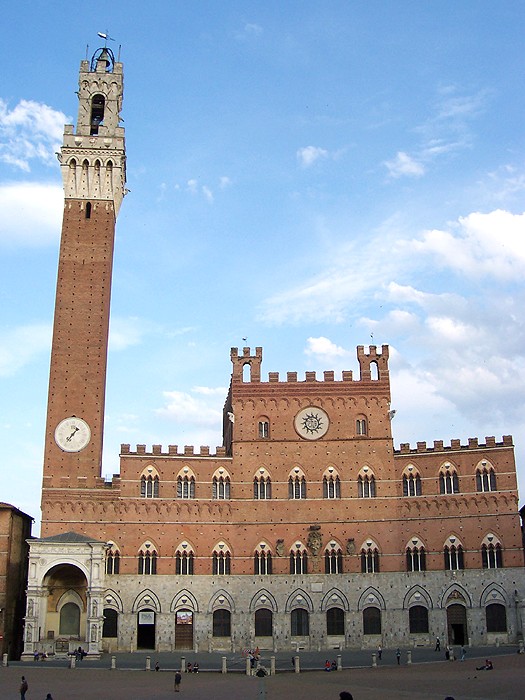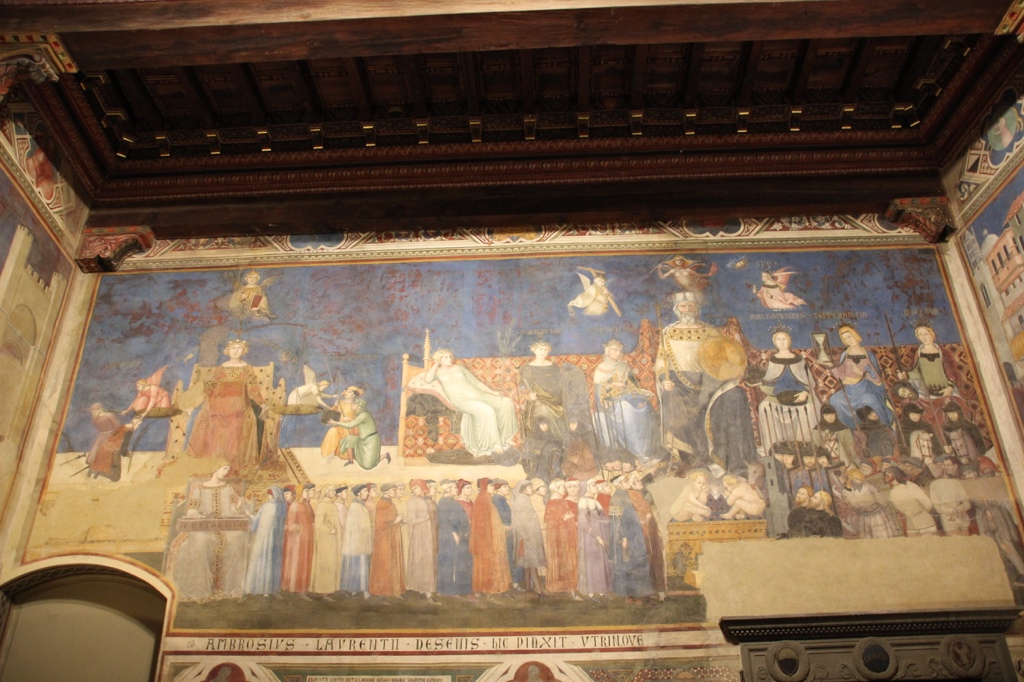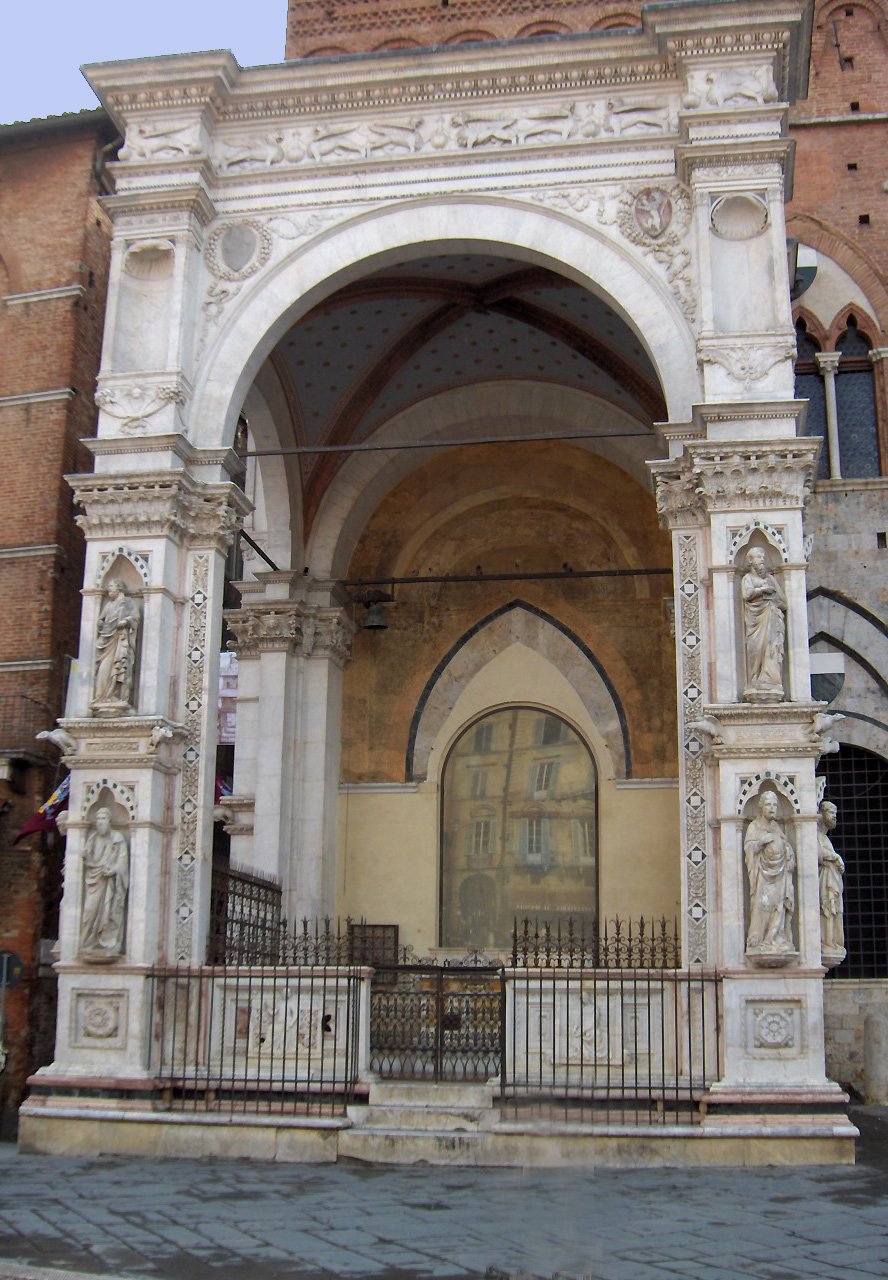Palazzo Pubblico on:
[Wikipedia]
[Google]
[Amazon]





 The Palazzo Pubblico (''town hall'') is a palace in
The Palazzo Pubblico (''town hall'') is a palace in


 The campanile or bell tower,
The campanile or bell tower,
 Nearly every major room in the palace contains frescoes. These were unusual for the time in that they were commissioned by the governing body of the city, rather than by the Church or by a religious fraternity. They are also unusual in that many of them depict secular subjects instead of the religious subjects which are overwhelmingly typical of Italian art of this era.
The most famous of the secular frescoes are three panels in the series on government in the Hall of the Nine (also known as Sala della Pace) by
Nearly every major room in the palace contains frescoes. These were unusual for the time in that they were commissioned by the governing body of the city, rather than by the Church or by a religious fraternity. They are also unusual in that many of them depict secular subjects instead of the religious subjects which are overwhelmingly typical of Italian art of this era.
The most famous of the secular frescoes are three panels in the series on government in the Hall of the Nine (also known as Sala della Pace) by
Page about the palace at goticomania.it
{{coord, 43, 19, 06, N, 11, 19, 53, E, region:IT_type:landmark_source:dewiki, display=title Buildings and structures completed in 1344 Pubblico City and town halls in Italy Romanesque architecture in Siena Art museums and galleries in Siena



 The Palazzo Pubblico (''town hall'') is a palace in
The Palazzo Pubblico (''town hall'') is a palace in Siena
Siena ( , ; lat, Sena Iulia) is a city in Tuscany, Italy. It is the capital of the province of Siena.
The city is historically linked to commercial and banking activities, having been a major banking center until the 13th and 14th centuri ...
, Tuscany
Tuscany ( ; it, Toscana ) is a Regions of Italy, region in central Italy with an area of about and a population of about 3.8 million inhabitants. The regional capital is Florence (''Firenze'').
Tuscany is known for its landscapes, history, art ...
, central Italy
Italy ( it, Italia ), officially the Italian Republic, ) or the Republic of Italy, is a country in Southern Europe. It is located in the middle of the Mediterranean Sea, and its territory largely coincides with the homonymous geographical re ...
. Construction began in 1297 to serve as the seat of the Republic of Siena
The Republic of Siena ( it, Repubblica di Siena, la, Respublica Senensis) was a historic state consisting of the city of Siena and its surrounding territory in Tuscany, central Italy. It existed for over 400 years, from 1125 to 1555. During its e ...
's government, which consisted of the Podestà
Podestà (, English: Potestate, Podesta) was the name given to the holder of the highest civil office in the government of the cities of Central and Northern Italy during the Late Middle Ages. Sometimes, it meant the chief magistrate of a city ...
and Council of Nine, the elected officials who performed executive
Executive ( exe., exec., execu.) may refer to:
Role or title
* Executive, a senior management role in an organization
** Chief executive officer (CEO), one of the highest-ranking corporate officers (executives) or administrators
** Executive dir ...
functions (and judicial
The judiciary (also known as the judicial system, judicature, judicial branch, judiciative branch, and court or judiciary system) is the system of courts that adjudicates legal disputes/disagreements and interprets, defends, and applies the law ...
ones in secular matters).
Architecture
The outside of the structure is an example of Italianmedieval architecture
Medieval architecture is architecture common in the Middle Ages, and includes religious, civil, and military buildings. Styles include pre-Romanesque, Romanesque, and Gothic. While most of the surviving medieval architecture is to be seen in c ...
with Gothic
Gothic or Gothics may refer to:
People and languages
*Goths or Gothic people, the ethnonym of a group of East Germanic tribes
**Gothic language, an extinct East Germanic language spoken by the Goths
**Crimean Gothic, the Gothic language spoken b ...
influences. The lower story is stone while the upper crenellated stories are made of brick. The facade of the palace is curved slightly inwards (concave) to reflect the outwards curve (convex) of the Piazza del Campo, Siena's central square
In Euclidean geometry, a square is a regular quadrilateral, which means that it has four equal sides and four equal angles (90- degree angles, π/2 radian angles, or right angles). It can also be defined as a rectangle with two equal-length a ...
, of which the Palace is the focal point. At the top of this facade is a huge round flat bronze plate hristogram the symbol used by Saint Bernardino. It was placed there by the government in 1425 in gratitude to the great preacher, a native Sienese, for his sermons aimed at quelling social and political factionalism and unrest.


 The campanile or bell tower,
The campanile or bell tower, Torre del Mangia
The Torre del Mangia is a tower in Siena, in the Tuscany region of Italy. Built in 1338-1348, it is located in the Piazza del Campo, Siena's main square, next to the Palazzo Pubblico (Town Hall). When built it was one of the tallest secular tow ...
, was built between 1325 and 1344; its crown was designed by the painter Lippo Memmi
Lippo Memmi (c. 1291 – 1356) was an Italian painter from Siena. He was the foremost follower of Simone Martini, who was his brother-in-law.
Together with Martini, in 1333 he painted what is regarded as one of the masterworks of the Intern ...
. The tower was designed to be taller than the tower in neighboring rival Florence
Florence ( ; it, Firenze ) is a city in Central Italy and the capital city of the Tuscany region. It is the most populated city in Tuscany, with 383,083 inhabitants in 2016, and over 1,520,000 in its metropolitan area.Bilancio demografico an ...
; at the time it was the tallest structure in Italy. It was fitted with a mechanical clock during the mid-14th century. Its design has been used as the basis for several other campaniles, including the Dock Tower in Grimsby
Grimsby or Great Grimsby is a port town and the administrative centre of North East Lincolnshire, Lincolnshire, England. Grimsby adjoins the town of Cleethorpes directly to the south-east forming a conurbation. Grimsby is north-east of Linco ...
, England, constructed in 1852 and the Joseph Chamberlain Memorial Clock Tower
The Joseph Chamberlain Memorial Clock Tower, or colloquially Old Joe, is a clock tower and campanile located in Chancellor's court at the University of Birmingham, in the suburb of Edgbaston. It is the tallest free-standing clock tower in the wo ...
in the Edgbaston campus of the University of Birmingham
, mottoeng = Through efforts to heights
, established = 1825 – Birmingham School of Medicine and Surgery1836 – Birmingham Royal School of Medicine and Surgery1843 – Queen's College1875 – Mason Science College1898 – Mason Univers ...
, which was completed in 1908.
Frescoes
 Nearly every major room in the palace contains frescoes. These were unusual for the time in that they were commissioned by the governing body of the city, rather than by the Church or by a religious fraternity. They are also unusual in that many of them depict secular subjects instead of the religious subjects which are overwhelmingly typical of Italian art of this era.
The most famous of the secular frescoes are three panels in the series on government in the Hall of the Nine (also known as Sala della Pace) by
Nearly every major room in the palace contains frescoes. These were unusual for the time in that they were commissioned by the governing body of the city, rather than by the Church or by a religious fraternity. They are also unusual in that many of them depict secular subjects instead of the religious subjects which are overwhelmingly typical of Italian art of this era.
The most famous of the secular frescoes are three panels in the series on government in the Hall of the Nine (also known as Sala della Pace) by Ambrogio Lorenzetti
Ambrogio Lorenzetti (; – 9 June 1348) or Ambruogio Laurati was an Italian painter of the Sienese school. He was active from approximately 1317 to 1348. He painted '' The Allegory of Good and Bad Government'' in the Sala dei Nove (Salon of Nin ...
.
These frescoes are collectively known as ''The Allegory of Good and Bad Government
''The Allegory of Good and Bad Government'' is a series of three fresco panels painted by Ambrogio Lorenzetti between February 1338 and May 1339. The paintings are located in Siena's Palazzo Pubblico—specifically in the ''Sala dei Nove'' ("Sal ...
''.
The Allegory of Good Government depicts the personification of Justice as a woman. She gestures to the scales of balance, held by the personification of Wisdom floating over her throne. On the viewer's left, a convicted criminal is beheaded; on the right, figures receive the rewards of justice. At Justice's feet, the personification of Virtue, also, unusually for the time, portrayed as a female figure, passes virtue among 24 faithfully rendered and recognizable images of prominent male citizens of Siena. The men face towards the largest figure in the image, a judge located in the center right. The judge is surrounded by additional personifications including Peace, who is represented as a fashionable, white-clad contemporary female figure with elaborate blonde hair
Blond (male) or blonde (female), also referred to as fair hair, is a hair color characterized by low levels of the dark pigment eumelanin. The resultant visible hue depends on various factors, but always has some yellowish color. The color can ...
.
The allegory carries a strong social message of the value of the stable republican government of Siena. It combines elements of secular life with references to the importance of religion: Justice resembles Mary, Queen of Heaven, the patron saint of Siena, on a throne; the Judge reflects the tradition in the Christian Last Judgment
The Last Judgment, Final Judgment, Day of Reckoning, Day of Judgment, Judgment Day, Doomsday, Day of Resurrection or The Day of the Lord (; ar, یوم القيامة, translit=Yawm al-Qiyāmah or ar, یوم الدین, translit=Yawm ad-Dīn, ...
to have God or Christ judging the saved on the left and the damned on the right. While classified as medieval or proto (pre)-renaissance art, these paintings show a transition from earlier religious art.
Flanking the Allegory are two other paintings on perpendicular walls: ''Effects of Good Government'' and ''Effects of Bad Government''. Both these frescoes depict a recognizable view of Siena and its countryside.
In the allegorical representation of Good Government, the prosperous townspeople are trading and dancing in the streets. Beyond the city walls is a lush countryside in which crops are harvested.
In the allegory of ''Bad Government'', crime is rampant and diseased citizens roam a crumbling city; the countryside suffers from drought.
Many of the frescoes in the Palace, including these, are badly damaged potentially due to salt once stored in the basement of the building. It is theoretically possible that the salts wicked moisture down from the walls, causing the plaster to dry excessively and the frescoes to flake off.
Other frescoes include that of Guidoriccio da Fogliano at the siege of Montemassi, located in the Great Council Hall (''Sala del Mappamondo''). The fresco is traditionally attributed to Simone Martini
Simone Martini ( – 1344) was an Italian painter born in Siena.
He was a major figure in the development of early Italian painting and greatly influenced the development of the International Gothic style.
It is thought that Martini was a pupil ...
, although there is debate on the subject. The wall has circular markings left by the circular wall-mounted (now lost) map of the world by Ambrogio Lorenzetti
Ambrogio Lorenzetti (; – 9 June 1348) or Ambruogio Laurati was an Italian painter of the Sienese school. He was active from approximately 1317 to 1348. He painted '' The Allegory of Good and Bad Government'' in the Sala dei Nove (Salon of Nin ...
.
Siena was decimated by the Black Death
The Black Death (also known as the Pestilence, the Great Mortality or the Plague) was a bubonic plague pandemic occurring in Western Eurasia and North Africa from 1346 to 1353. It is the most fatal pandemic recorded in human history, causi ...
in 1348; approximately half of its population died in the plague. The republic's economy was destroyed and the state quickly declined from its position of prominence in Italy. The Franciscan
The Franciscans are a group of related Mendicant orders, mendicant Christianity, Christian Catholic religious order, religious orders within the Catholic Church. Founded in 1209 by Italian Catholic friar Francis of Assisi, these orders include t ...
religious order rose to power in the city. The stagnation over the following centuries meant that while Siena did not develop during the Renaissance
The Renaissance ( , ) , from , with the same meanings. is a period in European history marking the transition from the Middle Ages to modernity and covering the 15th and 16th centuries, characterized by an effort to revive and surpass ideas ...
as did other Italian cities, it was also preserved both from bombardment during World War II
World War II or the Second World War, often abbreviated as WWII or WW2, was a world war that lasted from 1939 to 1945. It involved the vast majority of the world's countries—including all of the great powers—forming two opposin ...
and from modern development.
See also
* ''Annunciation'' (Ambrogio Lorenzetti), a painting originally in the palace * ''The Allegory of Good and Bad Government
''The Allegory of Good and Bad Government'' is a series of three fresco panels painted by Ambrogio Lorenzetti between February 1338 and May 1339. The paintings are located in Siena's Palazzo Pubblico—specifically in the ''Sala dei Nove'' ("Sal ...
'', a fresco by Ambrogio Lorenzetti
References
External links
Page about the palace at goticomania.it
{{coord, 43, 19, 06, N, 11, 19, 53, E, region:IT_type:landmark_source:dewiki, display=title Buildings and structures completed in 1344 Pubblico City and town halls in Italy Romanesque architecture in Siena Art museums and galleries in Siena